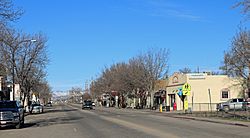Wellington, Colorado facts for kids
Quick facts for kids
Town of Wellington, Colorado
|
|
|---|---|

Looking west on Cleveland Avenue in Wellington.
|
|
| Nickname(s):
Colorado's Northern Gateway
|
|

Location of Wellington in Larimer County, Colorado.
|
|
| Country | |
| State | |
| County | Larimer County |
| Founded | 1902 |
| Incorporated | November 10, 1905 |
| Named for | C. L. Wellington |
| Government | |
| • Type | Statutory Town |
| Area | |
| • Total | 3.63 sq mi (9.41 km2) |
| • Land | 3.63 sq mi (9.40 km2) |
| • Water | 0.00 sq mi (0.01 km2) 0.0% |
| Elevation | 5,200 ft (1,585 m) |
| Population
(2020)
|
|
| • Total | 11,047 |
| • Estimate
(2021)
|
11,722 |
| • Density | 3,043/sq mi (1,174.0/km2) |
| Time zone | UTC-7 (MST) |
| • Summer (DST) | UTC-6 (MDT) |
| ZIP code |
80549
|
| Area code(s) | 970 |
| FIPS code | 08-83230 |
| GNIS feature ID | 0202441 |
| Website | Town of Wellington |
Wellington is a town in Larimer County, Colorado, United States. It is known as "Colorado's Northern Gateway." In 2020, about 11,047 people lived there. Wellington is located in the northern part of Colorado. It is also part of the larger Fort Collins-Loveland area.
Contents
Exploring Wellington's Location
Wellington is found in northern Colorado. It is the northernmost town in Colorado along I-25. This highway is a major route. The town covers an area of about 3.63 square miles (9.41 square kilometers). All of this area is land.
Wellington's Growing Population
| Historical population | |||
|---|---|---|---|
| Census | Pop. | %± | |
| 1910 | 459 | — | |
| 1920 | 439 | −4.4% | |
| 1930 | 533 | 21.4% | |
| 1940 | 465 | −12.8% | |
| 1950 | 541 | 16.3% | |
| 1960 | 532 | −1.7% | |
| 1970 | 691 | 29.9% | |
| 1980 | 1,215 | 75.8% | |
| 1990 | 1,340 | 10.3% | |
| 2000 | 2,672 | 99.4% | |
| 2010 | 6,289 | 135.4% | |
| 2020 | 11,047 | 75.7% | |
| 2021 (est.) | 11,722 | 86.4% | |
| U.S. Decennial Census 2020 | |||
Wellington has seen its population grow a lot over the years. In 2000, there were 2,672 people living in the town. By 2020, the population had grown to 11,047. This shows a big increase in people choosing to live in Wellington.
Most people in Wellington are White. About 12% of the population is of Hispanic or Latino background. The town has many families with children. In 2000, about 46% of households had kids under 18. The average age in Wellington was 30 years old. This means it's a relatively young community.
A Look at Wellington's Past
Wellington was founded in 1902. It became an official town in 1905. The town was named after C. L. Wellington. He was an employee of the Colorado and Southern Railroad.
Famous People from Wellington
A famous person who grew up in Wellington was Byron White. He became a Justice on the U.S. Supreme Court. He often came back to Wellington for his high school reunions. He continued this tradition until 1999.
Wellington in the Early 1900s
In the early 1900s, Wellington was a busy place. It was a service town for drivers. These drivers traveled between Cheyenne and Fort Collins. The town kept a population of around 500 people for many years. They built homes, restaurants, and churches. This helped create a small-town community.
Discovering Ancient Mammoths
In 2000, something amazing was found in Wellington. Construction workers were digging for new homes. They discovered the bones of a woolly mammoth. These are ancient, extinct animals. Scientists from Colorado State University came to carefully dig up the bones. Many Wellington residents watched this exciting event.
Unfortunately, the mammoth's tusks broke when they were lifted. However, parts of the skull and back teeth were saved. These bones are now at Colorado State University. The family who owned the land also kept some teeth. The street where the bones were found was named to remember this discovery.
Recent Growth in Wellington
Wellington has grown a lot since the 1990s. Many people now live there and travel to Fort Collins for work. Fort Collins is only about 10 miles south. This makes Wellington a popular place for people who want to live in a smaller town but work in a bigger city.
Learning in Wellington Schools
Wellington has three schools. They are all part of the Poudre School District. These schools are Rice Elementary, Eyestone Elementary, and Wellington Middle-High School. The former Wellington Middle School received many awards.
- National "School to Watch" (2012–2015)
- United States Department of Education National Green Ribbon School
- A.V.I.D International Demonstration School (2013–2016)
- Colorado Environmental Leadership Bronze Medal Award Winner (2012)
- National Yearbook Program of the Year (2012, 2013)
See also
 In Spanish: Wellington (Colorado) para niños
In Spanish: Wellington (Colorado) para niños

